Ravinder A1*, Waghray K2, Subbarao3 and Evangeline SJ4
1Department of Food Technology, JNTUA, Ananthapur, AP, India
2Department of Food Technology, Osmania University, Hyderabad, TS, India
3Department of Chemical Engineering, JNTUA, Ananthapuram, AP, India
4Department of Food Technology and Management, Loyola Academy Degree and PG College, Alwal, Secunderabad, TS, India
*Corresponding Author:
Ravinder A
Department of Experimental Medicine and Biotechnology
Research Block B, PGIMER
Chandigarh, India
Tel: 085542 73013
E-mail: lacademy_ftech@yahoo.co.in
Received Date: March 13, 2018; Accepted Date: April 20, 2018; Published Date: April 26, 2018
Citation: Ravinder A, Waghray K, Subbarao, Evangeline SJ (2018) Studies on Production of Gluten Free Products from Breadfruit Flour. J Food Nutr Popul Health Vol.2 No.1:8
DOI: 10.21767/2577-0586.10038
Keywords
Gluten; Breadfruit; Noodles
Introduction
Gluten
Gluten (from Latin gluten, “glue”) is a protein composite found in wheat and related grains, including barley and rye. Gluten gives elasticity to dough, helping it rise and keep its shape and often gives the final product a chewy texture. Gluten is used in cosmetics, hair products, and other dermatological preparations. Gluten is the composite of the storage proteins gliadin and a glutenin, and is conjoined with starch in the endosperm of various grass-related grains. The prolamin and glutelin from wheat (gliadin, which is alcohol-soluble, and glutenin, which is only soluble in dilute acids or alkalis) constitute about 80% of the protein contained in wheat fruit. Being insoluble in water, they can be purified by washing away the associated starch. Worldwide, gluten is a source of protein, both in foods prepared directly from sources containing it, and as an additive to foods otherwise low in protein [1-4].
Gluten intolerance is a growing epidemic in the U.S. and, increasingly, worldwide. Celiac sprue is a more specific disorder, characterized by gluten intolerance along with auto antibodies to the protein, transglutaminase, which builds crosslinks in undigested fragments of gliadin, a major constituent of gluten [5]. The auto antibodies are produced as an immune response to undegraded fragments of proteins in gluten. A remarkable set of symptoms develop over time in association with celiac disease, including weight loss, diarrhea, chronic fatigue, neurological disorders, anemia, nausea, skin rashes, depression, and nutrient deficiencies.
Breadfruit
Breadfruit (Artocarpus altilis) is a species of flowering tree in the mulberry family, Moraceae. It has long been an important staple crop and a primary component of traditional agroforestry systems in Oceania, where numerous varieties are grown. The fruit can be cooked and eaten at all stages of maturity, is high in carbohydrates, and is a good source of minerals and vitamins. In addition to producing abundant, nutritious, tastyfruits, this multipurpose tree provides medicine, construction materials, and animal feed. The attractive, ever green trees grow to heights of 15 to 21m (48 to 70ft) or more and the trunks may be as large as 2m (6.6ft) in diameter at the base. The trees begin bearing in 3-5 years and are productive for many decades. They are easy to propagate, require little attention and input of labor or materials, and can be grown under a wide range of ecological conditions [6-15]. Most breadfruit is produced for subsistence purposes and small quantities are available for sale in town markets as fresh fruit or chips [16].
A close relative of the breadfruit and breadnut is the jackfruit (Artocarpus heterophyllus), known for its enormously large fruit. Not common is St. Vincent, but worth mentioning also is a tree called breadnut or African breadfruit (Treculaia africana) that is grown for the seeds, which are ground into flour. This tree is also in the fig family [17-24].
Breadfruit has been processed into many forms for utilization in the food industry. It has also been processed into starches [22] and into flour [20,24]. Studies on the modification of breadfruit starch involving heat-moisture-treatment and annealing, as forms of physical modification collectively referred to as hydrothermal treatment which entail modification of temperature and moisture content have been carried out and reported by Adebowale et al. [1].
Noodles
Noodles are important foods throughout the world especially in Asian countries such as China, Korea, Malaysia, the Philippines and Thailand. Breadfruit starch has also been reported to contain high amylose (22.52%) and amylopectin (77.48%) [3]. Studies have shown that moderately high amylose foods are helpful in reducing risk factors for diabetes and cardiovascular diseases [12]. High amylopectin presence in food has also been reported to increase human insulin levels [13]. Furthermore, diets high in complex carbohydrates including high levels of starches according to Behall et al. [14] have been reported to normalize blood insulin and lipid levels in carbohydrate sensitive, diabetic, and hyper lipidemic individuals. Therefore, noodles produced from the blends of breadfruit starch and wheat flour with moderately high amylose and amylopectin might be explored as functional foods for normalizing the blood insulin levels and imparting other health benefits. Hence, the objective of this study is to produce noodles from breadfruit flour and investigate their proximate, culinary and sensory properties.
In this study, the main raw material is the flour made of breadfruit. This Breadfruit flour is used in the production of many food products without any fortification aiming to produce gluten free products. The products thus made were analyzed for its nutritional and mineral content as well as acceptability for the consumption.
Nutritional content in Breadfruit
Ragone [16] reported Sensory evaluation of fruit quality and nutritional composition of 20 breadfruit (Artocarpus, Moraceae) cultivars. Nutrient composition of 20 breadfruit varieties at the National Tropical Botanical Garden, Hawaii [per 100 g (approx. ½ cup) of edible portion] (Table 1).
Table 1 Nutritional content in Breadfruit.
| Nutrient |
Range |
Average |
| Energy (kcal) |
107-138 |
121 |
| Protein (g) |
0.6-1.3 |
1 |
| Carbohydrate(g) |
25-33 |
29 |
| Fat (g) |
0.1-0.2 |
0.2 |
| Fiber (g) |
2.1-7.4 |
5.2 |
| Water (g) |
65-73 |
69 |
| Calcium (mg) |
10-30 |
20 |
| Iron (mg) |
0.4-1.1 |
0.6 |
| Magnesium(mg) |
20-30 |
24 |
| Phosphorus(mg) |
18-41 |
32 |
| Sodium (mg) |
13-70 |
22 |
| Zinc (mg) |
0.07-0.13 |
0.1 |
| Copper (mg) |
0.04-0.15 |
0.1 |
| Manganese(mg) |
0.04-0.08 |
0.1 |
| α carotene(µg) |
8-20 |
13 |
| Vitamin C (mg) |
2-12 |
4 |
| Thiamin (mg) |
0.09-0.15 |
0.1 |
| Riboflavin (mg) |
0.02-0.05 |
0.03 |
| Niacin B3 (mg) |
0.75-1.4 |
1 |
Materials and Methods
The gluten free products from breadfruit are obtained from processing of fresh breadfruit to flour by dehydrating breadfruit slices followed by milling/grinding and thus the flour obtained is incorporated with other ingredients in order to produce several varieties of gluten free products such as Noodles, Manchuria, Phulka, Halwa etc. The process for the preparation of these products are similar to that of the regular products only varied with some ingredients and their proportions.
These products are made in different formulations (shown in Tables 2-5) fortified with maida, wheat flour, semolina, corn flour in order to check the taste, texture, appearance and overall acceptability, and thus finally to produce products without being fortified with any other materials than using only breadfruit flour.
Table 2 Formulations for Noodles.
| Maida |
|
Breadfruit flour |
| 1 |
: |
2 |
| 1 |
: |
3 |
| 1 |
: |
5 |
| 0 |
: |
1 |
Table 3 Formulations for Manchuria.
| Maida |
|
Corn flour |
|
Breadfruit flour |
| 2 |
: |
1 |
: |
1 |
| 1 |
: |
1 |
: |
2 |
| 1 |
: |
2 |
: |
1 |
| 2 |
: |
1 |
: |
2 |
| 0 |
: |
0 |
: |
1 |
Table 4 Formulations for Phulka.
| Breadfruit flour |
|
Wheat flour |
| 1 |
: |
2 |
| 1 |
: |
1 |
| 1 |
: |
0 |
Table 5 Formulations for Halwa.
| Semolina |
|
Wheat flour |
|
Breadfruit flour |
| 1 |
: |
1 |
: |
2 |
| 0 |
: |
1 |
: |
1 |
| 1 |
: |
0 |
: |
1 |
| 0 |
: |
0 |
: |
1 |
Analysis of nutritional content
Proximate analysis and nutritional content of the products are obtained by following different methods. Moisture content of the products are estimated by AOAC method, Total ash, Acid insoluble ash, sugars, acidity are estimated by standard chemical procedures. Fat, Crude fibre are determined by soxhlet apparatus and fiber analyzer respectively, Sodium(Na) and potassium (K) are determined by instrumental method Flame photometry, Phosphorus content is determined by Spectro photometry, Iron and Magnesium content is determined by using ICPMS (Inductively coupled plasma-mass spectrometry) method.
Sensory analysis
The sensory parameters of the products prepared from breadfruit flour are determined by group of panalists [15] in order to determine the appearance, texture, taste, flavor and overall acceptability.
Results and Discussions
The shelf life of the products can be maintained if store properly under required conditions. After attaining shelf life, products tend to show changes in the characteristics like, change in texture, smell, taste etc. In order to know the actual quality of the products, its nutritional changes, with increasing shelf life from the date of manufacturing, microbial and chemical analysis should be conducted at regular intervals of time (Figures 1-8) (Table 6).
Table 6 Shelf life of the products.
| S.no |
Product |
Storage temperature |
Shelf life |
| 1 |
Noodles |
Room temperature |
6 months |
| 2 |
Manchuria |
3-5°C |
4 months |
| 3 |
Halwa |
3-5°C |
4 months |
| 4 |
Phulka |
3-5°C |
5 days to 1 week |
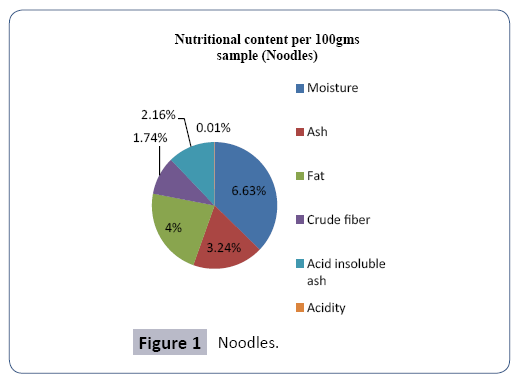
Figure 1: Noodles.
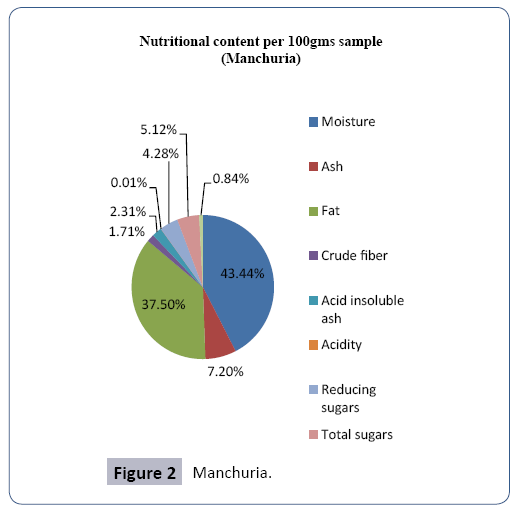
Figure 2: Manchuria.
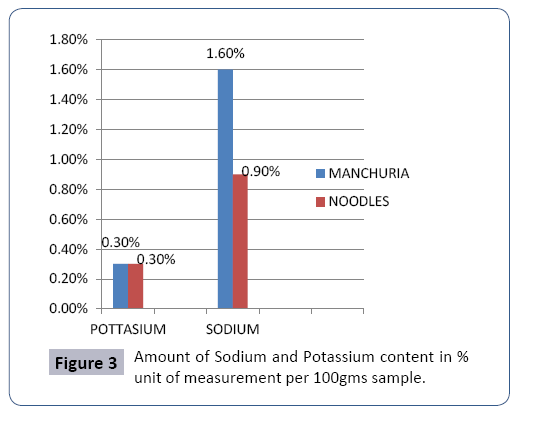
Figure 3: Amount of Sodium and Potassium content in % unit of measurement per 100gms sample.
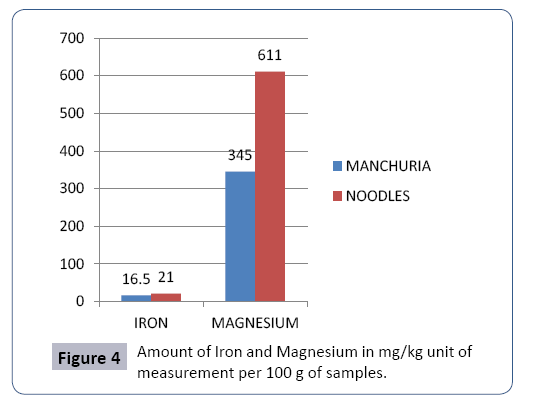
Figure 4: Amount of Iron and Magnesium in mg/kg unit of measurement per 100 g of samples.
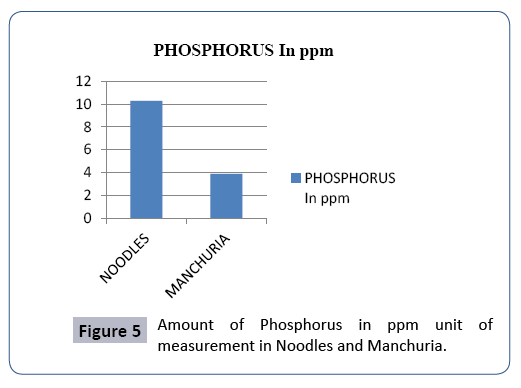
Figure 5: Amount of Phosphorus in ppm unit of measurement in Noodles and Manchuria.
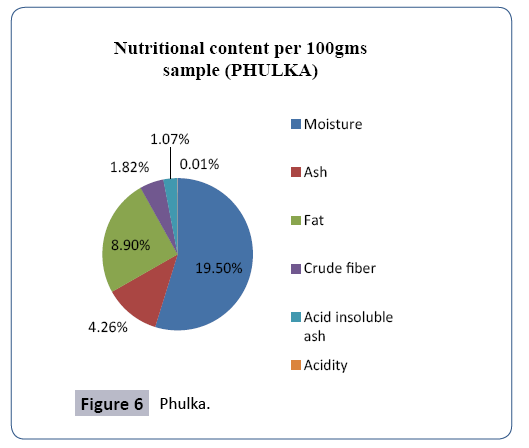
Figure 6: Phulka.
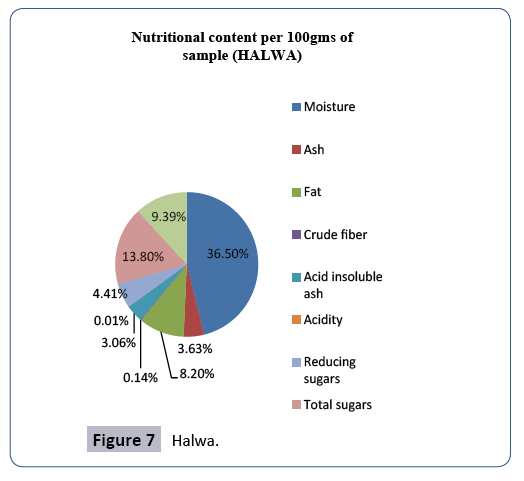
Figure 7: Halwa.
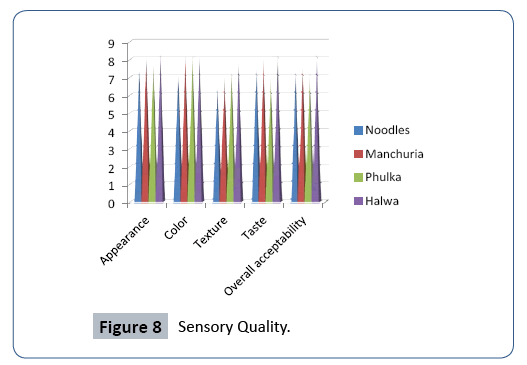
Figure 8: Sensory Quality.
Conclusion
The results of the present study revealed that beneficial gluten free products obtained from breadfruit flour with health promoting factors has superior proximate, culinary and sensory attributes. Since breadfruit is rich in minerals, carbohydrates and gluten free, it is considered as useful product that helps reducing symptoms of chronic constipation, risk of colon cancer and to minimize the symptoms related to celiac disease. Therefore, an inference can be drawn that the products obtained from the breadfruit flour are not just gluten free products but important functional foods.
References
- Adebowale KO, Olu-Owolabi BI, Olawumi EK, Lawal OS (2004) Functional properties of native, physically and chemically modified breadfruit (Artocarpus artilis) starch. Ind Crops Prod 21: 343-351.
- Agboola SO, Akingbala JO, Oguntimi GB (1990) Processing of cassava starch for adhesives production. Starch/Starke 42: 12-15.
- Akanbi TO, Nazamid S, Adebowale AA (2009) Functional and pasting properties of a tropical breadfruit (Artocarpus altilis) starch from Ile-Ife, Osun State, Nigeria. Int Food Res J 16: 151-157.
- Akanbi TO, Nazamid S, Adebowale AA, Farooq A, Olaoye AO (2011) Breadfruit starch-wheat flour noodles: preparation, proximate compositions and culinary properties. International Food Research Journal 18: 1283-1287
- Green PHR, Cellier C (2007) Celiac Disease. N Engl J Med 357: 1731-1743.
- American Gastroenterological Association (AGA) (2001) American Gastroenterological Association medial position statement: celiac sprue. Gastroenterol 120: 1522-1525.
- American Gastroenterological Association (2006) AGA Institute medical position statement on the diagnosis and management of celiac disease. Gastroenterol 131: 1977-1980.
- Anthony, S., and Stephanie, S. (2013) Glyphosate, pathways to modern diseases II: Celiac sprue and gluten intolerance. Interdiscip Toxicol 6: 159-184.
- Anthony, S, Stephanie S (2013) Glyphosate, pathways to modern diseases II: Celiac sprue and gluten intolerance. Interdiscip Toxicol 6: 159-184.
- Anitta V, Katri K, Liisa L, Ilkka K, Heikki P, et al. (2011) Clinical benefit of gluten-free diet in screen- detected older celiac disease patients. BMC Gastroenterology 11: 136.
- AOAC (1990) Official Methods of Analysis, Association of Official Analytical Chemist (15th Edn) Gaithersburg, USA: AOAC Press.
- Behall KM, Howe JC (1995) Effect of long-term consumption of amylose vs amylopectin starch on metabolic variables in human subjects. Am J Clin Nutr 61: 334-340.
- Behall KM, Scholfield DJ, Canary J (1988) Effect of starch structure on glucose and insulin responses in adults. Am J Clin Nutr 47: 428-432.
- Behall KM, Scholfield, DJ, Yuhaniak I, Canary J (1989) Diets containing high amylase vs amylopectin starch: effects on metabolic variables in human subjects. Am J Clin Nutr 49: 337-344.
- Cardello AV (1998) Perception of food quality. Food storage stability. Taub IA, Singh RP, CRC Press, New Delhi.
- Diane Ragone (2006) Species Profiles for Pacific Island Agro forestry.
- Dickson BC, Streutker CJ, Chetty R (2006) Celiac disease: an update for pathologists. J Clin Pathol 59: 1008-1016.
- Giovani BMC, Daniel PS, Camila VB, António AV, Jose AT, et al. (2010) Morbidity and mortality among older individuals with undiagnosed celiac disease. Gastroenterology 139: 763-769.
- Carvalho GBM, Silva DP, Bento CV, Vicente AA, Teixeira JA, et al. (2009) Banana as Adjunct in Beer Production: Applicability and Performance of Fermentative Parameters. J Appl Biochem Biotechnol 155: 53-62.
- Graham HD, De Bravo EN (1981) Composition of breadfruit. J Food Sci 46: 535-539.
- Lebegin SD, Lemerre, Mademba-Sy F (2007) Horti-cultural evaluation of five introduced and one local bread- fruit cultivar in New Caledonia. In Proceedings of the 1st International Symposium on Breadfruit Research and Development. Acta Horticulturae 757: 89-92.
- Loos PJ, Hood LF, Graham HD (1981) Isolation and Characterization of starch from Breadfruit. Journal of Cereal Chemistry 58: 282-286.
- Lu S, Oyvind M, Isabelle P, Felix H, Ferda F, et al. (2002) Structural Basis for Gluten Intolerance in Celiac Sprue. 297.
- Olatunji O, Akerele AJ (1978) Comparative rheological properties and bread qualities of wheat flour diluted with tropical tuber and Breadfruit flour. Journal of Cereal Chemistry 55: 1-6.
- Osabor DA, Ogar PC, Okafor, Egbung (2009) Profile of the African Bread Fruit (Treculia africana). Pakistan Journal of Nutrition 8: 1005-1008.









